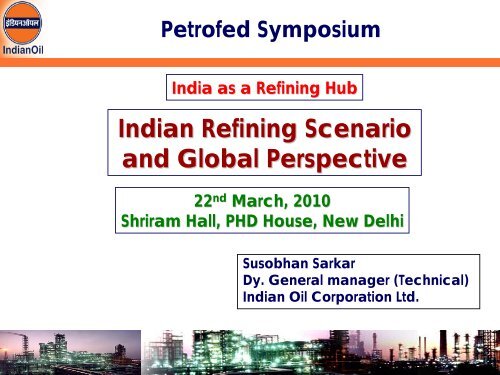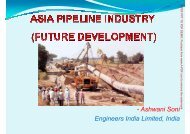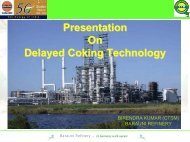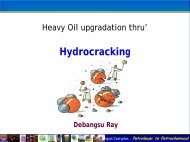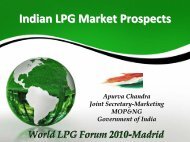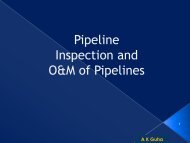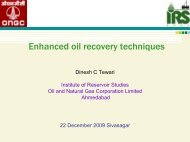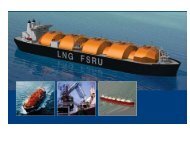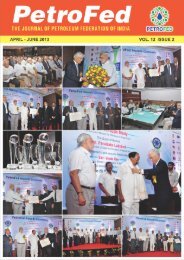Indian Refining Scenario and Global Perspective - petrofed ...
Indian Refining Scenario and Global Perspective - petrofed ...
Indian Refining Scenario and Global Perspective - petrofed ...
- No tags were found...
Create successful ePaper yourself
Turn your PDF publications into a flip-book with our unique Google optimized e-Paper software.
Petrofed SymposiumIndia as a <strong>Refining</strong> Hub<strong>Indian</strong> <strong>Refining</strong> <strong>Scenario</strong><strong>and</strong> <strong>Global</strong> <strong>Perspective</strong>22 nd March, 2010Shriram Hall, PHD House, New DelhiSusobhan SarkarDy. General manager (Technical)<strong>Indian</strong> Oil Corporation Ltd.
Structure of the presentation… <strong>Global</strong> <strong>Refining</strong> <strong>Scenario</strong> <strong>Indian</strong> <strong>Refining</strong> <strong>Scenario</strong><strong>Refining</strong> Challenge‣Future of Oil <strong>Refining</strong>: Technologies <strong>and</strong>Configuration‣Fuel Quality & Climate Change – Technologiesto address the issues
<strong>Global</strong> <strong>Refining</strong> <strong>Scenario</strong>
<strong>Global</strong> Oil <strong>Refining</strong> <strong>Scenario</strong>Regionwise no. of Refineries & Crude Processing CapacitiesAsia constitutes 23.4% of refineries <strong>and</strong> 26% of capacitySource: BP/OGJ 2007
REFINERY CAPACITIES(REGION-WISE SHARE)92010 Africa, S &C America21NorthAmerica2520625258Europe &EurasiaAsia PacificMiddle East1998 : 79.7 MMBPD 2008 : 88.6 MMBPDGLOBAL CAPACITY INCREASED BY ABOUT 9 MMBPD.INCREASE IN ASIA PACIFIC REGION IS ABOUT 5 MMBPDSource : BP Stats 2009
Source: OGJ 2007World <strong>Refining</strong>: Towards Economic SizeSmaller Refineries getting shut down…
World <strong>Refining</strong> Capacity Growth10080mmb/d6040200North America Latin America Europe FSU Africa Middle East AsiaAdditions ‘08‐15: World: 9.5 mmb/d Asia = 4.5‐5.0 mmb/d,7
<strong>Global</strong> <strong>Refining</strong> Scene—An Inconvenient Possibility105.0100.0World Dem<strong>and</strong> vs <strong>Refining</strong> Capacity—Announced Case*(*As per announced refining plans that we classify as firm <strong>and</strong> likely)World Total <strong>Refining</strong> CapacityWorld Conventional Oil Dem<strong>and</strong>**<strong>Refining</strong>‐Dem<strong>and</strong> GapIncreasingOvercapacity7.06.05.0mmb/d95.090.085.04.03.02.01.080.02008 2009 2010 2011 2012 2013 2014 2015** Excludes biofuels, GTL <strong>and</strong> others0.0Source : FACTS SEP, 20088
World Refinery Utilization Rates100%95%90%85%80%75%70%65%60%55%50%North America Latin America Europe FSUAfrica Middle East Asia World9Source : FACTS SEP, 2008
Product Balances<strong>Global</strong> Product Balance as per Announced <strong>Refining</strong> Plans2,5002,0001,500kb/d1,0005000‐500‐1,0002007 2010 2015LPG Naphtha Gasoline Jet/Kero Gasoil/Diesel Fuel oil10
<strong>Indian</strong> <strong>Refining</strong> <strong>Scenario</strong>
<strong>Indian</strong> RefineriesRefineries No. MMTPAIOC Group 10 60.2BPC group 3 22.5HPC 2 13.0ONGC/MRPL 2 9.8RIL (Pvt.) 2 62.0ESSAR 1 10.5Total 20 178.0JAMNAGAR(RIL 33.0 + 29.0)ESSAR 10.5+ 3.5)MUMBAI(BPC 12.0)(HPC 5.5+ 2.4)BHATINDA(9.0)MANGLORE(9.69 +5.31)BARODA(13.7)KOCHI(7.5 + 2.0)PANIPAT(12.0+3.0)MATHURA(8.0)BINA(6.0)CHENNAI(9.5+ 1.7)NARIMANAM(1.0)BARAUNI(6.0)TATIPAKA(0.08 + 0.08)(15.0)VISAKH(7.5+7.5)GUWAHATI(1.0)HALDIA(6.0+1.5)PARADEEPBONGAIGAON(2.35)DIGBOI(0.65)NUMALIGARH(3.0)Existing IOCSubsidiaries of IOCOthersNew / Additions
Refinery Capacity Utilisation200MMT180160140120100127.4127.4 132.47 130.1120.2122.4100 98.2132.4146.5131.7110.6148.9156.1140.7104.8177.9160.7145.31088060402002004-05 2005-06 2006-07 2007-08 2008-09Installed Capacity as on 1st April Throughput Capacity Utilisation ConsumptionAround 100% capacity utilization of <strong>Indian</strong> RefineriesSource:MOP&NG 2008
India : Downstream Industry Overview50(in MMTPA)403020100'97-98 '00-01 '01-02 '02-03 '03-04 '04-05 '05-06 '06-07 '07-08 08-09*ImportsExportsImport/Export Products onlySince 2001-02, India has transformed from being a net importer ofpetroleum products to being a net exporter<strong>Indian</strong> Hydrocarbon sector has acquired the critical mass for major productivity leaps
India : <strong>Refining</strong> Capacity Growth350300MMTPA3022502001501005027117127 127 13290 94 94 9933 33 3310644149731061781597623520210002003 2004 2005 2006 2007 2009 2012* 2017*PVT PSU Total* XIth Plan Projection• As on April 1, 2009, India has a total refining capacity of 178 MMTPA (including the newlycommissioned RIL refinery at Jamnagar)• 18 out of the total 20 refineries in India belong to PSUs (with a capacity of a little over 59%)• In the last few years, the <strong>Indian</strong> refinery sector has witnessed continuous capacityadditions <strong>and</strong> the trend will continue in near future also; Projected capacity by 2017 is 302MMTPA
India : Product Dem<strong>and</strong> & <strong>Refining</strong> Capacity350300Gap between <strong>Refining</strong> Capacity & Product Dem<strong>and</strong>30225023514020015017842136 1351001621005002008-09 2011-12 2016-17<strong>Refining</strong> Cap (MMT)Product Dem<strong>and</strong> (MMT)Surplus refining capacity is expected to increase further by 2030India will continue to be product surplusImport/Export requirement for crude/products to be quite substantialource: PPAC/ Draft XI Plan Dem<strong>and</strong> Document
<strong>Refining</strong> Challenges
<strong>Refining</strong> Challenge• Crude Oil Sourcing/ Oil Security• Margin Improvement• Environmental Issues• Funding for New Projects
Wide gaps between product dem<strong>and</strong> <strong>and</strong>indigenous crude availability• Widening gap between product dem<strong>and</strong> <strong>and</strong> crude productionfrom indigenous sources; Heavy dependence on Imports• Bridging the gap - Oil Equity abroad <strong>and</strong> fresh finds under NewExploration & Licensing Policy• Need for huge investments in refining, pipelines & MarketinginfrastructureSource: XIth Plan Document
Crude Sourcing/Oil Security• Crude Potential available from existing fields in Middle East, Africa <strong>and</strong> SouthAmerican countries to support refining capacity expansion <strong>and</strong> sustaincapacity utilization• Efforts for new finds– Attractive New Exploration Licensing Policy (NELP)• 206 oil & gas exploration blocks awarded in 7 rounds• 68 major discoveries reported• Investment commitments of the order of $ 10 billion• Huge Unexplored acreage• World’s biggest deep water gas discovery made in 2002 (K-G Basin)– India Hydrocarbon Vision – 2025• 100% exploration coverage of all sedimentary basins by 2025• Internationally competitive fiscal terms• Alternative sources : CBM <strong>and</strong> Gas Hydrates
Oil Security: Strategic Storage• Storage & Supply Infrastructure– Integrated Energy Policy recommended 90 days storage of oilimports– Present storage coverage is 74 days <strong>and</strong> will reduce to 63 dayswith increase in the oil imports– Storage capacity augmentation actions have been taken toenhance the total storage capacity to 78 days.– Planned capacity addition: 8.62 MMT• 5.33 MMT by ISPRL at Vizag, Mangalore <strong>and</strong> Padur• 3.29 MMT at other locations– Strategic storage to provide addl. 12 days cover
Margin Improvement• Refinery Configuration/ Complexity FactorImprovement to address– Changing Feed Stocks : Input costreduction– Product Mix improvement : Value addition• Energy Efficiency improvement
Refinery Configuration/ ComplexityChanging Feedstocks : Input Cost Reduction• Quality – 0 API / Sulfur / Acidity• Widening of crude basket• New Frontiers - Unconventional sources - Tar s<strong>and</strong>s,Oil shales• Compulsion to co-process feed-stocks of Bio-origin
7 7 713 14 1554 56 5726 23 21
Increase in Upgrading Ratio Driving the Market80.070.060.050.040.030.020.0North AmericaLatin AmericaEuropeFSUAsiaMiddle EastWorld10.00.026Source : FACTS SEP, 2008Upgrading Ratio % (FCC equivalent/CDU Capacity)
Source : Mckinsey
Resid Upgradation ProcessesFCCSource : Shell <strong>Global</strong> Solutions
Slurry HydroCrackingFuture Resid TechnologyResidProcessResidProcess with HVGO Recyce
Energy Efficiency Improvement• Energy efficiency improvement by use of– Energy efficient technologies/designs– Energy efficient equipments– Best operation <strong>and</strong> maintenance practices• GHG emission reduction through energy efficiencyimprovement• Close monitoring <strong>and</strong> timely actions bridge the gap in specificenergy consumption to match with the global best• Tools applied are: Pinch Technology, Hydrogen Management,Waste Heat Recovery, Steam Power balance (CogenerationCycle)• Increased utilization of gas in place of conventional liquid fuel
Energy Reduction(MBTU/BBL/NRGF)90807060502002-03 2003-04 2004-05 2005-06 2006-07 2007-08 2008-09IOC 85 77 77 73 71 67 64INDUSTRY 89 84 81 77 74 71 69
Environment Issues• Managing new norms– Environmental• Quality upgradation requirements• GHG emission– Societal (Corporate Social Responsibility)– Regulatory <strong>and</strong> legislative norms– Sustainability
Transportation Fuel QualityNorth AmericaEuropeFSU & Central AsiaAfricaAsia & OceaniaS & C AmericaWorldwide Reduction in Sulphur Content in HSD & MS
Environmental Issues: Stringent Product Quality NormsAUTO FUEL POLICY : Aligning with global normsProduct Quality Parameters Equivalent LocationsSulphur – 50 ppm (max)Benzene – 1 % (max)Aromatics – 35 % (max)Olefins – 21 % (max)Euro IV13 Major citiesby April 2010PetrolSulphur – 150 ppm (max)Benzene – 1% (max)Aromatics – 42% (max)Olefins – 21% (max)Euro III13 Major cities- CurrentRest of the country – by April 2010Sulphur – 500 ppm (max)Benzene – 3% (max)Euro IIRest of the country - CurrentCetane No – 51Sulphur – 50 ppm (max)95% Rec. – 360 0 CPAH – 11% (max)Euro IV13 Major citiesby April 2010DieselCetane No – 51Sulphur – 350 ppm (max)95% Rec. – 360 0 CPAH – 11% (max)Euro III13 Major cities- CurrentRest of the country – by April 2010Cetane No. 48Sulphur – 500 ppm (max)95% Rec, - 3700CEuro IIRest of the country - Current
CLIMATE CHANGEIncreased conc. of GHGs (CO2, CH4, N2O, PFCs, HFCs, SF6) inatmosphere due to increased human activities (last 150 years)have resulted into following climate change :Increase in CO2 concentration from 278 to 386 PPM(Threshold Value of CO2 : 350 ppm)CO2 beyond 450 PPM will make <strong>Global</strong> climate more hostile.Avg. global temp. rise : 0.74 o C in last 100 years.Climate change phenomenon has put a serious social <strong>and</strong>economic challenges on mankind.
GHG EMISSION BY COUNTRIESCountries Survey CO2 Eq MMT Population Per capitaYear(Millions) CO2 eqAustralia 2000 535 (VII) 19.44 27.54USA 2002 6746 (I) 280 24.09Canada 2004 740 (VI) 31.56 23.45RussianFederationEuropeanUnion1999 1880 (IV) 145.60 12.911999 4030 (II) 375.30 10.74China 1994 3650 (III) 1198.50 3.05India 2001 1228 (V) 914.00 1.34( ) Position based on discharge volume Source: carbon planet.com
Futuristic Refinery• Highly automated, integrated <strong>and</strong> energy efficient withhigh level of heat integration.• Capable to process variety of crude oils to reduce cost ofraw material Heavy <strong>and</strong> sour crude, High Acid Crude withappropriate metallurgyAlternative crude oils derived from Tar s<strong>and</strong>s <strong>and</strong> shaleoils• Matching desulphurisation capability for production of 10ppm sulphur auto fuels (Euro-V spec.) including ATF <strong>and</strong>Kerosene.• High performance fuels <strong>and</strong> lube oil basestocks• Zero residue• Zero flare
Futuristic Refinery• Hydrogen, power <strong>and</strong> steam production throughGasification of coal/coke <strong>and</strong> biomass.• Integration with biorefining: Production of secondgeneration bio-fuels <strong>and</strong> co-processing of biofuels inexisting refinery units.• Technology innovation to develop <strong>and</strong> adopt processesbased on biotechnology, super efficient catalysts & fuelsadditives through application of nano-science.• The performance of refineries in future will be judgedmore by their success in conserving resources like energy<strong>and</strong> water <strong>and</strong> minimizing carbon footprints. Adoption of clean technologies for reduction of GHGemission CO 2 sequestration <strong>and</strong> revenue from carbon credits Zero effluent, rain water harvesting <strong>and</strong> seawaterdesalination for coastal refineries
Funding New Projects• Investment plans for India’s downstream petroleumindustry for the period 2007-2012; ~ US $55 bn• Investment planned by IOCL in the similar period is ~US $11 bn– <strong>Refining</strong> Sector: 59%– Petrochemicals: 27%– Pipelines, Marketing <strong>and</strong> others: 14%• Majority of available fund is getting diverted in development ofnational infrastructure like power generation, roads/highways,rail, airports, ports etc. which are essential for developingcountry like India
Asia Pacific Supply -Dem<strong>and</strong>Balance 2010-2030
Asian Dem<strong>and</strong> TrendsOil Product Dem<strong>and</strong> by Country, 1970-201512,00010,000kb/d8,0006,0004,000ChinaJapanS. KoreaIndiaIndonesiaThail<strong>and</strong>TaiwanAustraliaSingaporeMalaysiaOthers2,0000Asia Dem<strong>and</strong> Highlights, ’07‐15:China: 4.9%/year (+400‐420 kb/d/year); India: 4.3%/year (+120‐130 kb/d/year); Japan: 856 kb/d/yr dem<strong>and</strong> declineTotal Asia: 2.7%/year42
Incremental Dem<strong>and</strong> in AsiaIncremental Dem<strong>and</strong> – Main Asian Markets(2006-2025, Million tons per year)300Million tons per year250200150100500Naphtha Gasoline Jet/Kerosene DieselHistorically Chinahas invested tomeet its owndem<strong>and</strong>, <strong>and</strong> thisis expected tocontinue, asevidenced by themany firmprojects currentlyunderwayChina India IndonesiaVietnam Thail<strong>and</strong> OtherSource : Nexants, 2007
Asia Pacific <strong>Refining</strong> Capacity AdditionAsia Pacific <strong>Refining</strong> Capacity Likely Changes Through 2015Crude Distillation CapacityChinaJapanS KoreaIndiaSingaporeTaiwanIndonesiaThail<strong>and</strong>AustraliaMalaysiaPakistanPhilippinesN Zeal<strong>and</strong>N KoreaMyanmarSri LankaPNGBangladeshBruneiVietnamMongoliaJuly 2007 CapacityAdd 2007-10Add 2011-15*(500) 1,500 3,500 5,500 7,500 9,500kb/d* For refining additions after 2010, assumptions have been made based on announced plans <strong>and</strong> supply <strong>and</strong> dem<strong>and</strong> situation.Asia Additions, ’08‐15: CDU: 6.3 mmb/d Conversion: 3.1 mmb/d Treating: 2.7 mmb/d44Source : FACTS SEP, 2008
Supply Deficit : Regional SpecificsAtlantic Basin• High dem<strong>and</strong> growth for light & middle distillates• Tight emission norms leading to dismantling of smallerunits• Limited investments in new capacity creationPacific Basin• Economic growth leading to robust POL dem<strong>and</strong>• Additional investments to meet fuel quality norms• Closure of uneconomic & marginal capacity units
Supply Deficit : Regional Drivers• The projected increase in dem<strong>and</strong>, coupled withcapacity rationalization expected to lead to shortfall inrefining capacity• Though a steady dem<strong>and</strong> growth exists, capacityadditions are limited around the world• Several regions are expected to face supply constraintsover the next 5 years• Projected capacity additions as per announced planscannot meet the dem<strong>and</strong>
Supply Deficit : Regional Drivers• 75% of Middle East production available for AsiaPacific, Eastern Europe, Latin America <strong>and</strong> Africa.• Balance assumed to serve North America <strong>and</strong> Europedem<strong>and</strong>• Middle East (capacity addition) & Eastern Europe(increased capacity utilization) expected to emergeas key export centres• Even after accounting increased supply, there wouldbe unmet dem<strong>and</strong> in both Atlantic & Pacific basin
North AmericaDeficit: 43MS: 24Jet kero: 19Surplus: 68LPG: 19Naphtha:15HSD: 5FO: 14Others: 15Net: (+) 25Latin AmericaDeficit: 50Naphtha: 7MS: 10HSD: 32Others: 1Surplus: 30LPG: 5FO: 25Net: (-) 20Regional product balance, 2020EuropeDeficit: 145LPG: 17Naphtha: 23Jet kero: 54HSD: 49Surplus: 133MS: 126FO: 7Net: (-) 12AfricaDeficit: 71LPG: 5MS: 24Jetkero: 3HSD: 38Others: 1Surplus: 36Naphtha:11FO: 25Net: (-) 35Middle EastDeficit: 31MS: 26Others: 5Surplus: 188LPG: 85Naphtha:44Jet/kero: 19HSD: 17FO: 23Net: (+) 157• By 2020, world would be net product deficit @ 247 MMTPA– 100 MMT surplus (LPG:49 & Fuel Oil:51)FSU/RussiaDeficit: 13MS: 7Jetkero: 4Others: 3Surplus: 71LPG: 1Naphtha:2HSD: 34FO: 34Net: (+) 58All figures in MMTPAAsia PacificDeficit: 419LPG: 40Naphtha: 56MS: 107Jet kero: 26HSD: 86Others: 28Surplus: 0Net: (-) 419Source: PEL– 347 MMT deficit (Naphtha:15, MS:72, Jet/kero:88, HSD:147 & Others:25)
Future of Oil <strong>Refining</strong>Technologies & Configuration
Future DirectionsSupply Dem<strong>and</strong>• Fossil fuel to continue to mainstay of energy source innear future.• Era of easy oil nearing over. In future, deep oil, tar s<strong>and</strong><strong>and</strong> shale oil to supplement oil need.• Flexi refineries to h<strong>and</strong>le a wide range of crude oilsfrom high naphthenic acid to high Sulphur levels <strong>and</strong>new sources of oil like Shale Oils.• Feed quality improvement through demetallation ofcrude oil <strong>and</strong> heavy residues without affecting life ofcatalysts.Positive on water <strong>and</strong> neutral on carbon” will be the guidingoperating philosophy for future to sustain business.
Technological Interventions/Innovation To Process wide varieties of Crude (Heavy/High TAN/HS) : Feedmanagement tool for optimal operation of secondary/treating units Advanced Technology/Catalyst System capable of processing difficultfeeds with higher Sulphur, Nitrogen, metals, CCR/Asphaltenes etc, Bottom of the barrel up gradation : Minimization of low value/low dem<strong>and</strong>product Upgradation of low value/surplus products‣ PetCoke Gasification : Power, H2 generation, Chemicals To meet Stringent Product quality in cost effective manner : OptimumHydrogen Consumption Efficiency Improvement in operation
Energy Efficiency Improvement• Energy efficiency improvement by use of– Energy efficient technologies/designs– Energy efficient equipments– Best operation <strong>and</strong> maintenance practices• GHG emission reduction through energy efficiency improvement• Close monitoring <strong>and</strong> timely actions bridge the gap in specificenergy consumption to match with the global best• Tools applied are: Pinch Technology, Hydrogen Management, WasteHeat Recovery, Steam Power balance (Cogeneration Cycle)• Increased utilization of gas in place of conventional liquid fuel
Future Directions• Large-scale production of biofuels from algae• Alcohol from lingo cellulosic material• Processing of non-edible vegetable oils in refineriesalong with diesel in existing units.• Pyrolysis of biomass <strong>and</strong> gasification of biomass, petresidue<strong>and</strong> coke.• Hydrogen production through water splitting usinglow-grade heat/ solar concentrators or renewablesources such as wind / solar energy.Following complete integration of petroleum refinery withpetrochemicals, the next era will be refineries integratingwith biorefining <strong>and</strong> CTX.
Future DirectionsBiomassOilCoalBiomass is once again heralded as a global energy saviour along withfossil fuelsFollowing complete integration of petroleum refinery withpetrochemicals, the next era will be refineries integrating withbiorefining <strong>and</strong> CTL
Future DirectionsIntegration with Biorefining <strong>and</strong> CTLLPGIsom, (1940)AlkylationGasolineCO 2 SequestrationSolventsBio RfiningAlcoholDieselCoalPetcokeBiomassCDUCTL/CTXARVDU1870NaphthaKerosene/ATF/MTOGas OilVRCoker1932VGOCRU(1952)LPGFCC1942Coke GasolinePPFNaphthaTCOCLOHC1960Aromatics (BTX)GasolineH 2DHDS1954GasolineHSDCatalyticDewaxing1975HSDSyngas
Future DirectionsCTX ProcessesUse of existing refinery infrastructure
Fuel Quality & Climate ChangeTechnologies to address theissues
Future DirectionsEnvironmental Regulations• Stabilizing GHG emissions to sustainable 450 ppmlevel, believed to be limiting temperature rise to nomore than 2 0 C above the pre-industrial level,remains a significant challenge.• Integrated R&D needed with thrust on developingappropriate environment friendly cleanertechnologies <strong>and</strong> to constantly realigntechnological options having least carbon-footprint.
Future Directions• Technology selection increasingly be influenced by taxes (thatmay be imposed) on polluters, carbon credits, governmentalm<strong>and</strong>ates for reduction of pollution <strong>and</strong> use of fuels derived fromrenewable sources.• Currently deployed technologies, that do not address the concernof global warming, to lose their relevance.• Development <strong>and</strong> Realigning of technological options having leastcarbon-footprint will be required.• Increasing use of hydroprocessing for fuel quality improvement/desulphurisation.• Shift towards cleaner fuels richer in hydrogen or to neat hydrogen<strong>and</strong> renewables.
Future Direction• Intensive use of kinetic models <strong>and</strong> simulators for Prediction ofproperties <strong>and</strong> optimization of process variables. Improvingefficiency of process internals• Improving efficiency of operations/ hardware• Greater Underst<strong>and</strong>ing of catalysts at sub atomic level <strong>and</strong> developcost effective, more active <strong>and</strong> more selective catalyst forimproving efficiency <strong>and</strong> capacity• Application of biotechnology <strong>and</strong> Nanotechnology<strong>Refining</strong> over a period of time has changed fromphysical separation to molecular transformation,wherein catalysts play major role.


